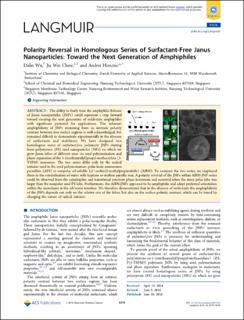Please use this identifier to cite or link to this item:
https://doi.org/10.21256/zhaw-3593| Publication type: | Article in scientific journal |
| Type of review: | Peer review (publication) |
| Title: | Polarity reversal in homologous series of surfactant-free Janus nanoparticles : toward the next generation of amphiphiles |
| Authors: | Wu, Dalin Chew, Jia Wei Honciuc, Andrei |
| DOI: | 10.21256/zhaw-3593 10.1021/acs.langmuir.6b01422 |
| Published in: | Langmuir |
| Volume(Issue): | 32 |
| Issue: | 25 |
| Page(s): | 6376 |
| Pages to: | 6386 |
| Issue Date: | 2016 |
| Publisher / Ed. Institution: | American Chemical Society |
| ISSN: | 0743-7463 1520-5827 |
| Language: | English |
| Subject (DDC): | 500: Natural sciences 540: Chemistry |
| Abstract: | The ability to finely tune the amphiphilic balance of Janus nanoparticles (JNPs) could represent a step forward toward creating the next generation of solid-state amphiphiles with significant potential for applications. The inherent amphiphilicity of JNPs stemming from an intrinsic polarity contrast between two surface regions is well-acknowledged, but remained difficult to demonstrate experimentally in the absence of surfactants and stabilizers. We have designed two homologous series of surfactant-free polymeric JNPs starting from polystyrene (PS) seed nanoparticles (NPs) on which we grew Janus lobes of different sizes via seed polymerization and phase separation of the 3-(triethoxysilyl)propyl-methacrylate (3-TSPM) monomer. The two series differ only by the radical initiator used in the seed polymerization: polar ionic ammonium persulfate (APS) vs nonpolar oil-soluble 2,2'-azobis(2-methylpropionitrile) (AIBN). To compare the two series, we employed them in the emulsification of water with heptane or molten paraffin wax. A polarity reversal of the JNPs within AIBN-JNP series could be observed from the catastrophic and transitional emulsion phase inversions and occurred when the more polar lobe was larger than the nonpolar seed PS lobe. Furthermore, the AIBN-JNPs appeared to be amphiphilic and adopt preferred orientation within the monolayer at the oil/water interface. We therefore demonstrated that in the absence of surfactants the amphiphilicity of the JNPs depends not only on the relative size of the lobes, but also on the surface polarity contrast, which can be tuned by changing the nature of radical initiator. |
| URI: | https://digitalcollection.zhaw.ch/handle/11475/5464 |
| Fulltext version: | Published version |
| License (according to publishing contract): | Licence according to publishing contract |
| Departement: | Life Sciences and Facility Management |
| Organisational Unit: | Institute of Chemistry and Biotechnology (ICBT) |
| Appears in collections: | Publikationen Life Sciences und Facility Management |
Files in This Item:
| File | Description | Size | Format | |
|---|---|---|---|---|
| acs-langmuir-6b01422.pdf | 2.44 MB | Adobe PDF |  View/Open |
Show full item record
Wu, D., Chew, J. W., & Honciuc, A. (2016). Polarity reversal in homologous series of surfactant-free Janus nanoparticles : toward the next generation of amphiphiles. Langmuir, 32(25), 6376–6386. https://doi.org/10.21256/zhaw-3593
Wu, D., Chew, J.W. and Honciuc, A. (2016) ‘Polarity reversal in homologous series of surfactant-free Janus nanoparticles : toward the next generation of amphiphiles’, Langmuir, 32(25), pp. 6376–6386. Available at: https://doi.org/10.21256/zhaw-3593.
D. Wu, J. W. Chew, and A. Honciuc, “Polarity reversal in homologous series of surfactant-free Janus nanoparticles : toward the next generation of amphiphiles,” Langmuir, vol. 32, no. 25, pp. 6376–6386, 2016, doi: 10.21256/zhaw-3593.
WU, Dalin, Jia Wei CHEW und Andrei HONCIUC, 2016. Polarity reversal in homologous series of surfactant-free Janus nanoparticles : toward the next generation of amphiphiles. Langmuir. 2016. Bd. 32, Nr. 25, S. 6376–6386. DOI 10.21256/zhaw-3593
Wu, Dalin, Jia Wei Chew, and Andrei Honciuc. 2016. “Polarity Reversal in Homologous Series of Surfactant-Free Janus Nanoparticles : Toward the next Generation of Amphiphiles.” Langmuir 32 (25): 6376–86. https://doi.org/10.21256/zhaw-3593.
Wu, Dalin, et al. “Polarity Reversal in Homologous Series of Surfactant-Free Janus Nanoparticles : Toward the next Generation of Amphiphiles.” Langmuir, vol. 32, no. 25, 2016, pp. 6376–86, https://doi.org/10.21256/zhaw-3593.
Items in DSpace are protected by copyright, with all rights reserved, unless otherwise indicated.